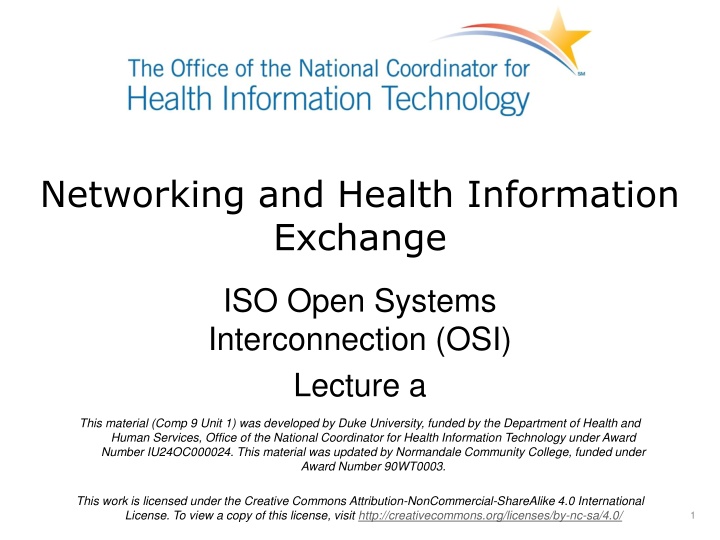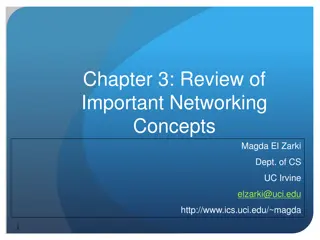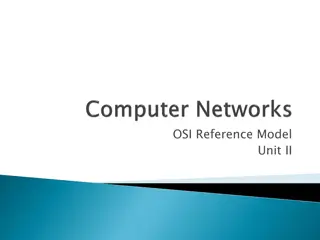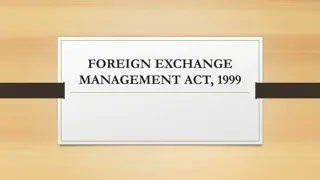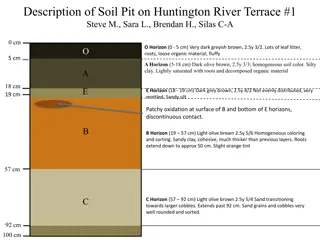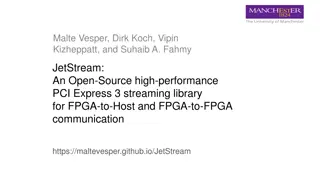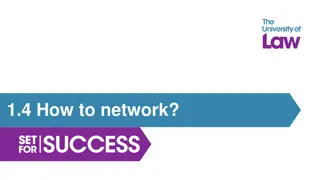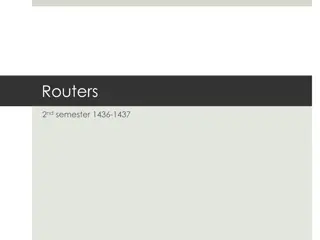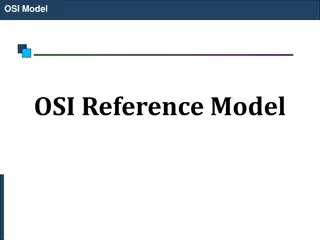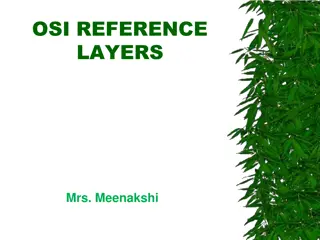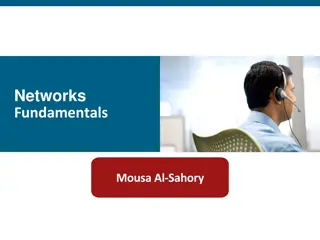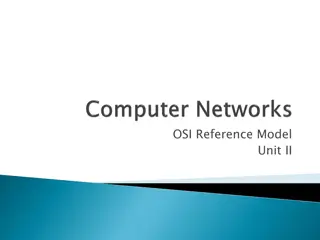Networking and Health Information Exchange: Understanding OSI Layers
The OSI model and its layers, including networking functions, terminology, protocols, and TCP/IP models. Learn about LANs, WANs, the Internet, and communication essentials for network connections.
Download Presentation

Please find below an Image/Link to download the presentation.
The content on the website is provided AS IS for your information and personal use only. It may not be sold, licensed, or shared on other websites without obtaining consent from the author.If you encounter any issues during the download, it is possible that the publisher has removed the file from their server.
You are allowed to download the files provided on this website for personal or commercial use, subject to the condition that they are used lawfully. All files are the property of their respective owners.
The content on the website is provided AS IS for your information and personal use only. It may not be sold, licensed, or shared on other websites without obtaining consent from the author.
E N D
Presentation Transcript
Networking and Health Information Exchange ISO Open Systems Interconnection (OSI) Lecture a This material (Comp 9 Unit 1) was developed by Duke University, funded by the Department of Health and Human Services, Office of the National Coordinator for Health Information Technology under Award Number IU24OC000024. This material was updated by Normandale Community College, funded under Award Number 90WT0003. This work is licensed under the Creative Commons Attribution-NonCommercial-ShareAlike 4.0 International License. To view a copy of this license, visit http://creativecommons.org/licenses/by-nc-sa/4.0/ 1
ISO Open System Interconnection (OSI) Objectives Explain the OSI representation of the various layers involved in networking, including the general functions of each layer and their interconnections. Explain the concept of the Application Layer Explain the concept of the Presentation Layer Explain the concept of the Session Layer Explain the concept of the Transport Layer 2
Terminology A network is two or more devices that communicate with each other over some form of transmission media. Types of networks Local Area Network (LAN) Wide Area Network (WAN) Internet Intranet Extranet 3
Terminology - 2 For communication to take place on a network we need Source Receiver Medium 4
Terminology - 3 Protocol rules for communication Examples: TCP/IP-Transmission Control Protocol/Internet Protocol HTTP-HyperText Transfer Protocol NETBEUI-NetBios Extended User Interface ICMP-Internet Control Message Protocol 5
TCP/IP Model Application Transport Internetwork Network Access Table 1.1 TCP/IP Four-Layer Model for Internet Communications Source: Parrish, Michele. 2011 6
OSI Model Application Presentation Session Transport Network Data Link Physical Table 1.2 OSI Seven-Layer Model for Internet Communications Source: Parrish, Michele. 2011 7
Protocol Data Units (PDUs) Image courtesy of Michele Parrish 10
Protocols/Technologies Covered Image courtesy of Michele Parrish 11
Application Layer Protocols Hypertext Transfer Protocol (HTTP) is used by Web browsers and servers to communicate. Domain Name Service (DNS) is used for converting host names and domain names into IP addresses. Simple Mail Transport Protocol (SMTP) is used for email. POP3 IMAP4 12
Application Layer Protocols Continued Dynamic Host Configuration Protocol (DHCP) is used to automatically configure network hosts with TCP/IP settings. File Transfer Protocol (FTP) is used to copy files from one host to another. Telnet allows a user to connect to a remote system and whatever action they perform on their local host happens on the remote system. 13
Presentation Layer Protocols Multipurpose Internet Mail Extensions (MIME) specifies how messages must be formatted so that they can be exchanged between different email systems. External Data Representation(XDR) is a standard for the description and encoding of data. Source for MIME: http://www.networkdictionary.com/protocols/mime.php Source for XDR: http://tools.ietf.org/html/rfc1014 14
Presentation Layer Protocols Continued Transport Layer Security (TLS) and its predecessor, Secure Socket Layer (SSL) are used to encrypt/decrypt data. Data Compression/Decompression is also done at this layer. 15
Session Layer Establishes connections Authentication Type of communication that will take place Protocols that will be used by the lower layers Maintains connections Synchronizes communications 16
Session Layer Continued Control dialogues Keeps track of which device is making requests and which device is making responses Determines whether acknowledgments are required Terminates connections 17
Transport Layer Protocols Transmission Control Protocol (TCP) maintains reliable, ordered delivery of segments. Connection-oriented Sequence Numbers Acknowledgements Window Sizing 18
Transport Layer Protocols Continued User Datagram Protocol (UDP) provides best effort delivery of datagrams. Connectionless Errors may be handled by higher level protocols. Minimal Lower Layer Protocol (MLLP) is an interface between HL7 applications and TCP. Source: http://www.interfaceware.com/llp.html 23
TCP/UDP Ports Assigned by the Internet Assigned Numbers Authority (IANA) Three different types of port numbers Well-known ports (0 to 1023) Registered ports (1024 to 49151) Dynamic or private ports (49152 to 65535) 24
TCP/UDP Ports - 2 Application HTTP HTPS SMTP DHCP FTP Protocol TCP TCP TCP UDP TCP Port Number 80 443 25 67 20 (data) 21 (control) 23 53 Telnet DNS TCP TCP/UDP Table 1.3 Application, Protocol and Port Numbers Source: Parrish, Michele. 2011 25
ISO Open Systems Interconnection (OSI) Summary In this lecture we covered the TCP/IP model the OSI model the Application layer the Presentation layer the Session layer and the Transport layer. 26
ISO Open Systems Interconnection (OSI) References Lecture a References MIME: Multipurpose Internet Mail Extensions. (n.d.). Retrieved January 6, 2012, from Network Dictionary website: http://www.networkdictionary.com/protocols/mime.php Network Working Group. (1987, June). XDR: External Data Representation Standard. Retrieved from Sun Microsystems website: http://tools.ietf.org/html/rfc1014 LLP - Lower Layer Protocol. (n.d.). Retrieved January 6, 2012, from iNTERFACEWARE http://www.interfaceware.com/llp.html Inc. website: Charts, Tables, Figures 1.1 Table: Parrish, Michele. 2011. 1.2 Table: Parrish, Michele. 2011. 1.3 Table: Parrish, Michele. 2011. Images Slide 5: Source, Medium and Receiver. Courtesy Michele Parrish. Used with permission. Slide 9: OSI Model showing layers and their functions. Courtesy Michele Parrish. Used with permission. Slide 10: Model Comparison. Courtesy Michele Parrish. Used with permission. Slide 11: PDU. Courtesy Michele Parrish. Used with permission. Slide 12: Protocols. Courtesy Michele Parrish. Used with permission. Slide 20: Handshake. Courtesy Michele Parrish. Used with permission. Slide 21: Sequence. Courtesy Michele Parrish. Used with permission. Slide 22: Acknowledgements. Courtesy Michele Parrish. Used with permission. Slide 23: Window Sizing. Courtesy Michele Parrish. Used with permission. 27
ISO Open Systems Interconnection (OSI) Lecture a This material was developed by Duke University, funded by the Department of Health and Human Services, Office of the National Coordinator for Health Information Technology under Award Number IU24OC000024. This material was updated by Normandale Community College, funded under Award Number 90WT0003. 28
